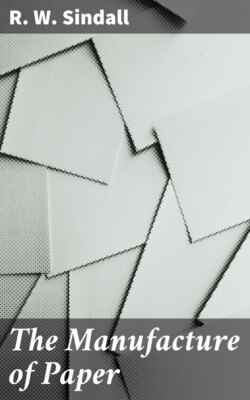Читать книгу The Manufacture of Paper - R. W. Sindall - Страница 5
На сайте Литреса книга снята с продажи.
Оглавление| About | |
| 1496. | First attempts at paper-making by John Tate at Hertford. |
| 1496. | Tate's paper used by Wynkyn de Worde in “De Proprietatibus Rerum.” |
| 1557. | A paper mill in existence at Fenditton, Cambridge. |
| 1569. | A mill at Bemmarton, Wilts. |
| 1574. | Mill erected at Osterley, Middlesex, by Sir Thomas Gresham. |
| 1585. | Richard Tottyl asked for sole right to make paper for thirty-one years, which was not granted. |
| 1588. | John Spilman erected a mill at Dartford, Kent. Granted a patent for sole manufacture of paper. |
| 1588. | Churchyard's poem on the “Paper Myll built near Darthford by Master Spilman.” |
| 1612. | Robert Heyricke's mill at Cannock Chase, Staffordshire. |
| 1636. | The three or four paper mills in the neighbourhood of Hounslow and Colnbrook temporarily shut down on account of the plague, the collection of rags having been forbidden. |
| 1665. | Patent granted to Charles Hildeyard for an invention, “the way and art of making blew paper used by sugar bakers and others.” |
| 1675. | Approximate date of erection of mills at Wolvercote, Oxford, where the Oxford India paper is now made. |
| 1678. | Mill at Byfleet, Surrey, mentioned by Evelyn in his diary. |
| 1682. | Bladen—A patent for an engine and process whereby rags are wrought into paper. |
| 1684. | Baysmaker—A patent for “the art and mistery of making paper in whole sheets.” |
| 1684. | Jackson—A patent for “an engine, either for wind or water, which prepareth all materials whereof paper may be made.” Evidently Jackson was acquainted with the “Hollander” beating engine. |
| 1686. | A charter granted to the “White Paper Makers' Company” for the sole right of making paper exceeding 4s. a ream in value. |
| 1674. | Annual importation of paper, presumably from France, stated to be 160,000 reams, of average value of 5s. (Somers). |
| 1689. | Trade with France prohibited by royal proclamation. |
| 1696. | Price of paper very high owing to scarcity, being 11s. per ream. |
| 1712. | Duties levied on all kinds of paper, manufactured or imported. |
| 1725. | Monopoly of making paper for Bank of England notes granted to De Portal, of the Laverstoke mills, Hampshire. This paper is still made by the firm of Messrs. Portal. |
| 1739. | Galliott and Parry estimated that there were 600 paper mills in England, making 6,000 reams a day. The Commissioner of Excise reported only 278. |
| 1739. | James Whatman erected a mill at Boxley, Maidstone. |
| 1758. | Baskerville printed an edition of Virgil on so-called “woven” paper. |
Early Methods.—The most rapid development of the industry appears to have taken place in Holland. The rags used for paper-making were moistened with water and stored up in heaps until they fermented and became hot. By this means the dirt and non-fibrous matter was rendered partially soluble, so that on washing a suitable paper pulp was obtained. The washed rags were then placed in a stamping machine resembling an ordinary pestle and mortar. The mortars were constructed of stone and wood, and the stamps were kept in motion by levers which were raised by projections fixed on the shaft of a waterwheel. The operation of beating thus occupied a long period, but the paper produced was of great strength.
The invention of the “Hollander,” a simple yet ingenious engine which is deservedly known by the name of the country in which it first originated, gave a tremendous impetus to the art of paper-making, as by its means the quantity of material which could be treated in twenty-four hours was greatly increased. Unfortunately the date of the invention of this important machine has not been definitely traced. The earliest mention of it seems to occur in Sturm's “Vollständige Mühlen Baukunst,” published in 1718. It was in extensive use at Saardam in 1697, so that the invention is at least some years previous to 1690.
On this point Koops says: “In Gelderland are a great many mills, but some so small that they are only able to make 400 reams of paper annually, and there are also water mills with stampers, like those in Germany. But in the province of Holland there are windmills, with cutting and grinding engines, which do more in two hours than the others do in twelve. In Saardam 1,000 persons are employed in paper-making.”
